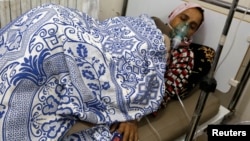Kurdish commanders in eastern Syria say Islamic State militants used poison gas Wednesday to attack Kurdish fighters. The accusation came as civilians in the northern Syrian town of Marea, 10 kilometers from the Turkish border, also said they have, for the second time in recent weeks, come under a barrage of shells filled with mustard gas.
Syrian Kurdish leaders sent a specialized investigation team to the alleged gas attack site in the Salihiya area of Syria’s Hasaka province, which has seen fierce fighting for weeks between Islamic militants and the Kurdish People's Protection Units (YPG).
“I felt the gas; it was really pungent and had a nasty smell. I was barely breathing and I thought I was choking,” a civilian told Rudaw, a Kurdish news site.
Mustard gas
The attack Wednesday in Hasaka came two days after a rocket suspected of carrying chemical substances was fired by the Islamic State at Iraqi Kurdish Peshmerga positions near Mosul Dam. Mustard gas causes serious damage to the skin, eyes, respiratory and other internal organs.
In a statement, the Kurdistan Region Security Council said the rocket used near the Mosul Dam was homemade and “the impact produced considerable yellow smoke at the scene of the attack, leaving one Peshmerga requiring treatment.”
“We are working with the international coalition to collect samples for immediate tests abroad. This is one of an increasing number of attacks… suspected of carrying chemical substances,” the council said.
Mounting allegations
Since early last month, allegations have mounted about the Islamic State group's use of mustard gas, the infamous chemical agent first used in combat in World War I. On August 12, during a battle near the northern Iraqi city of Makhmour, 60 Peshmerga troops were exposed to mustard gas, according to Kurdish officials.
During a long artillery bombardment on August 21 in which 59 shells landed on Marea, the northern Syrian rebel stronghold which is being besieged by IS, at least 25 people suffered some of the symptoms associated with the chemical weapon banned under the 1925 Geneva protocol. The symptoms include blistering and weeping skin, a burning rash and breathing difficulties.
U.S. and German officials have concluded the allegations about the use of mustard gas in the August attacks are credible. A senior U.S. military official said the ordnance fired at the Peshmerga produced injuries with "wounds consistent with a blister-producing agent” and that preliminary testing of mortar shell fragments from Makhmour showed traces of sulfur mustard.
Testimony from doctors and chemical weapons experts is adding weight to the claims of IS mustard gas use. They say the skin lesions and other symptoms suggest exposure to a chemical agent.
The non-profit Syrian-American Medical Association, in a statement after the first Marea attack, said the agent used was likely mustard gas. The association runs a field hospital in the town just north of Aleppo. The French medical charity Médecins Sans Frontières said its doctors treated a family exhibiting symptoms of exposure to chemical agents. All four family members had respiratory complications and developed weeping skin blisters several hours after the mortar barrage.
Dutch-born IS fighter Omar Yilmaz last week acknowledged the extremist group’s use of mustard gas, saying in a Tumblr post, “The regime uses chemical warfare on a regular basis these days, and nobody bats an eye - yet when [IS] captures it from them and uses it against them it’s all of a sudden a huge problem?”
Still an open question
Despite his claim that the chemical weapons used were seized from captured Syrian government bases, U.S. and NATO officials say it is still an open question as to where IS got the mustard gas. Although the Syrian regime cooperated with the destruction of most of its chemical arsenal after the threat of U.S. airstrikes two years ago, following a sarin gas attack on the Damascus suburb of Ghouta, United Nations inspectors have expressed concern that not all mustard gas stocks were burned away in sand pits as the regime claimed.
Experts argue that any stockpiles that may have escaped international weapons inspectors still around in Iraq from the Saddam Hussein era would be degraded by now. Some experts have speculated that mustard gas-filled shells may have been smuggled out of Libya. The likely low concentrations of gas used in the alleged IS attacks suggest the chemical weapon was developed by IS itself using precursor chemicals bought on the black market.
Since the Syrian government’s destruction of its chemical arsenal under a deal brokered by Russia, there have been persistent claims that forces loyal to President Bashar al-Assad have also been using poison gas mainly in airstrikes. Syrian civil defense workers and doctors have documented dozens of cases and Syrian rebel commanders say that between March and May, more than 1,000 people were wounded in chlorine gas attacks, which claimed at least a dozen lives.
Last month, the United Nations Security Council passed a resolution setting up a team to investigate chemical weapons attacks in Syria. On Wednesday, Russia, a key foreign backer of President Assad, held up final approval for the probe on technical grounds. Russian diplomats said the probe should also focus on the alleged IS attacks and be extended to investigate claims of poison gas use in neighboring Iraq as well.








